The ultimate soft synth showdown: Serum 2, Pigments 6, Phase Plant, Vital and Massive X: But which is best?
We pit five of today's most powerful, flexible and versatile synth plugins against each other to find out who comes out on top in 2025

PLUGIN WEEK 2025: With the physical constraints of hardware cost, weight, size and how much power they use removed, it's safe to say that today's modern synth plugin designers have got it easy compared to their contemporaries Bob Moog, Tom Oberheim, Dave Smith, Wolfgang Palm, and more.
And while the old classics were borne of their ability to strike a perfect balance between capability and practicality, there are no such rules to obey today. Yesterday's synth heroes worked in the physical world, discovering and sourcing new components and getting them all in one place to work together reliably.
Today's designers of modern software synths face no such constraints. Once they have a computer model for an oscillator, a filter, or an envelope, they can cram as many of these models as you like into a synth without adding any expense or impracticality.
Their only limit is the power of the user's CPU and, these days, that's not much of a limit at all!
And so with all this power, reliability and innovation we're in the midst of something of a golden age for synths where, for just a couple-of-hundred quid/dollars/euros, you can purchase the most powerful, flexible, and gob-smackingly impressive instruments ever created, creating a market for uber-synths all aiming out outgun each other.
These are synths that are both able to emulate practically any other and produce new sounds that are all their own.
Which only begs the question which is best? And which should you splash your hard-earned cash on?
Want all the hottest music and gear news, reviews, deals, features and more, direct to your inbox? Sign up here.
Let's find out...
Arturia Pigments 6

Arturia are old hands at this game, having quickly focused its attentions on creating computer models of hard-to-find hardware, realising the market for aspiring synth nerd who dreamed of finally owning their own rack of card-carrying classics.
As its collection of synths and plugins grew, so did its repository of algorithms, so, when it turned its attention to creating its own original soft-synth, the company had a vast back catalogue of know-how and code to draw from.
The result of all their know-how is Pigments.
Pigments is a monster synth that features a multi-engine design that allows a range of different sound generators, filters and FX processors to be combined within a patch. It's the best of Arturia… In one synth.
It features three sound generation engines. One of these is a "Utility" engine with two noise generators and a single analogue-style oscillator, perfect for use as a sub-oscillator or drone. The other two generator slots can load any one of five different synthesis models. These are:
- Analogue provides the three-oscillator setup found on many classic synths, with common waveforms, frequency modulation and oscillator sync.
- Wavetable is a powerful and versatile wavetable engine replete with large library of wavetables and the ability to import custom wavetables.
- Sample can host up to six sample articulations, and can operate as a classic sampler or be switched into a granular mode.
- Harmonic is an approachable implementation of additive synthesis.
- Modal is a physical modelling engine based on Karplus-Strong synthesis.
This selection may not cover every synthesis technology ever, but it's more than enough to give Pigments an exceptionally varied voice.
More options are available in the filter section, which offers two slots that can be arranged in series or parallel.
There's a large choice of filter models available to load into these, with various flavours of low-pass, band-pass and high-pass models, along with a collection of more specialized filters such as comb, formant and cluster filters and some filters taken directly from Arturia's instrument collection (Minimoog, MS-20, Jupiter 8, and more).

The filters feed to an FX section featuring two insert effects busses and one send effects bus, with each bus able to host three effect processors.
As with the filters, there's a range of standard effects – reverbs, delays, and what-have-you – alongside processors taken from Arturia's other products – a Juno-6 chorus or BL-20 flanger, for example. Like we said – it's a greatest hits mash-up!
All of this is backed up with an intuitive and powerful modulation system that provides three each of envelopes, LFOs, function curves, random generators and modulation combinators
All of this is backed up with an intuitive and powerful modulation system that provides three each of envelopes, LFOs, function curves, random generators and modulation combinators. These are easy to assign via drag-and-drop – the technique favoured by all the synths we're looking at – with each mapping also available as a destination for other modulators to modulate.
Pigments also boasts a powerful arpeggiator/pattern sequencer packed with enough generative, polyrhythmic and randomisation features to keep even the most experimental producer happy.
Pleasingly, as well as driving Pigments, the arpeggiator/sequencer can also output MIDI, and so can be used to sequence other synths.
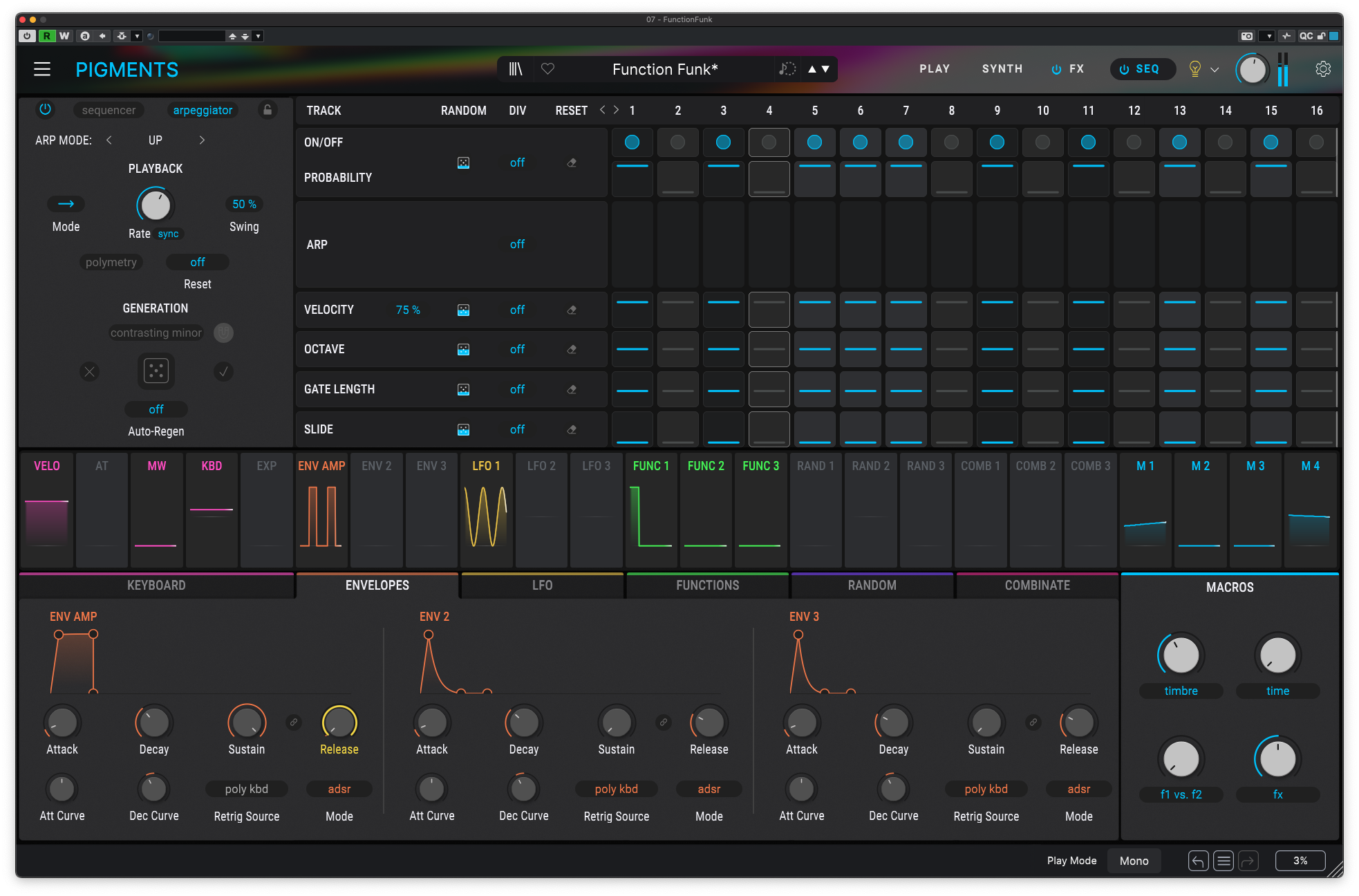
Summing up
Pigments is good-looking, easy-to-use, and sounds fantastic. It can at times get greedy for system resources but this all depends on the patch – the Analogue and Sample engines are very efficient, but fire up a Harmonic engine or two and the demands can rise sharply, especially if setting the engine to generate a large number of partials.
The synth comes with a huge library of patches, samples and wavetables, and can run standalone or as a plugin.
Verdict
Flexibility: 4
Ease-of-Use: 4
Sound: 5
Value: 4
Sound examples
Price: €199
Contact: arturia.com
Kilohearts Phase Plant

Not one you may have considered but well worth your time, Kilohearts' series of "Snapin" plugins are a collection of processors that, individually, perform a single, focused task, but which can also be combined in complex ways within one of the company's three host plugins.
For effects there's Snap Heap and Multipass, and for instruments there's Phase Plant, which is what's of specific interest to us here.
The Snapin system makes Phase Plant by far the most flexible and modular synth in this roundup. An initial patch starts as a completely blank slate, and is divided into three sections: The Generator section is the hosting area for the main synth components, such as oscillators, filters and amps). The Lanes section provides three busses for hosting additional effects and processors, and which can be routing destinations for output modules within the Generator area.
Finally, the Modulators section allows any selection of envelopes, LFOs, and other modulation sources to be loaded and then assigned to any of the multitude of modulatable parameters within the patch.
Creating patches is simply a case of clicking in one of the sections and choosing Snapins from the list of compatible options that's shown.
And, by virtue of 'building' the synth yourself you'll find it perhaps the most easy to understand (while offering predictable) results. There are no 'what's that bit' or 'why is that there'… Everything is here in the chain because you put it there, making it great for learning about sound design and synthesis.
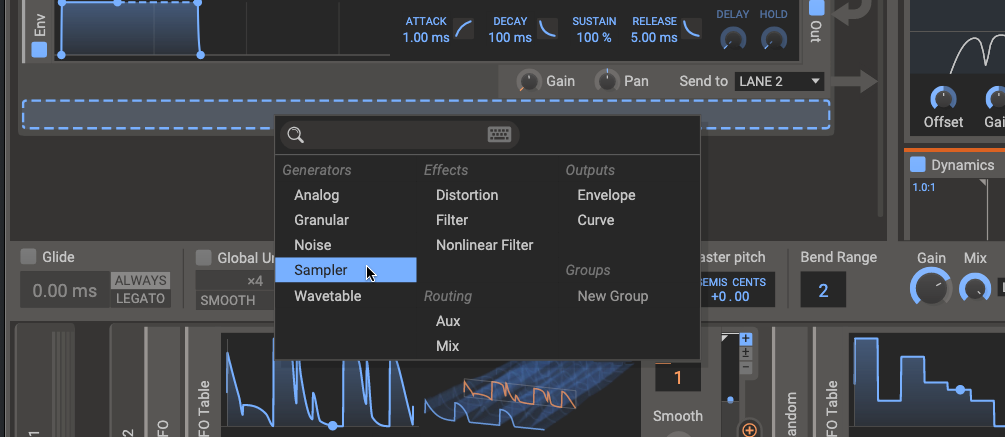
The Generator section is where sound generators, filters, and amplifiers are loaded. These are always arranged into groups, with a group needing at least one sound generator Snapin and one output Snapin for routing the sound to the Lanes section.
There are five sound generator models available, each with a self-explanatory name: Analogue, Granular, Noise, Sampler and Wavetable. To these you can add a couple of types of filter, a distortion processor, two flavours of amp envelope, and a few mixing and routing processors.
Synths can therefore be very simple with very clear design and predictable responses. Or – with the capacity to host up to 32 Snapins, and the ability to route audio signals between Snapins and groups – the Generator section ultimately allows for some phenomenally complex instruments and patches to be created.
Each of the three Lanes can load any processing Snapin installed on the system. There are additional filters, dynamics processors, distortion processors, reverb, ring modulation, EQ... the list is huge.
The Modulators section is similarly generous, with a wide choice of different realtime, automatic and utility modulators with which to add control and variation to a patch.
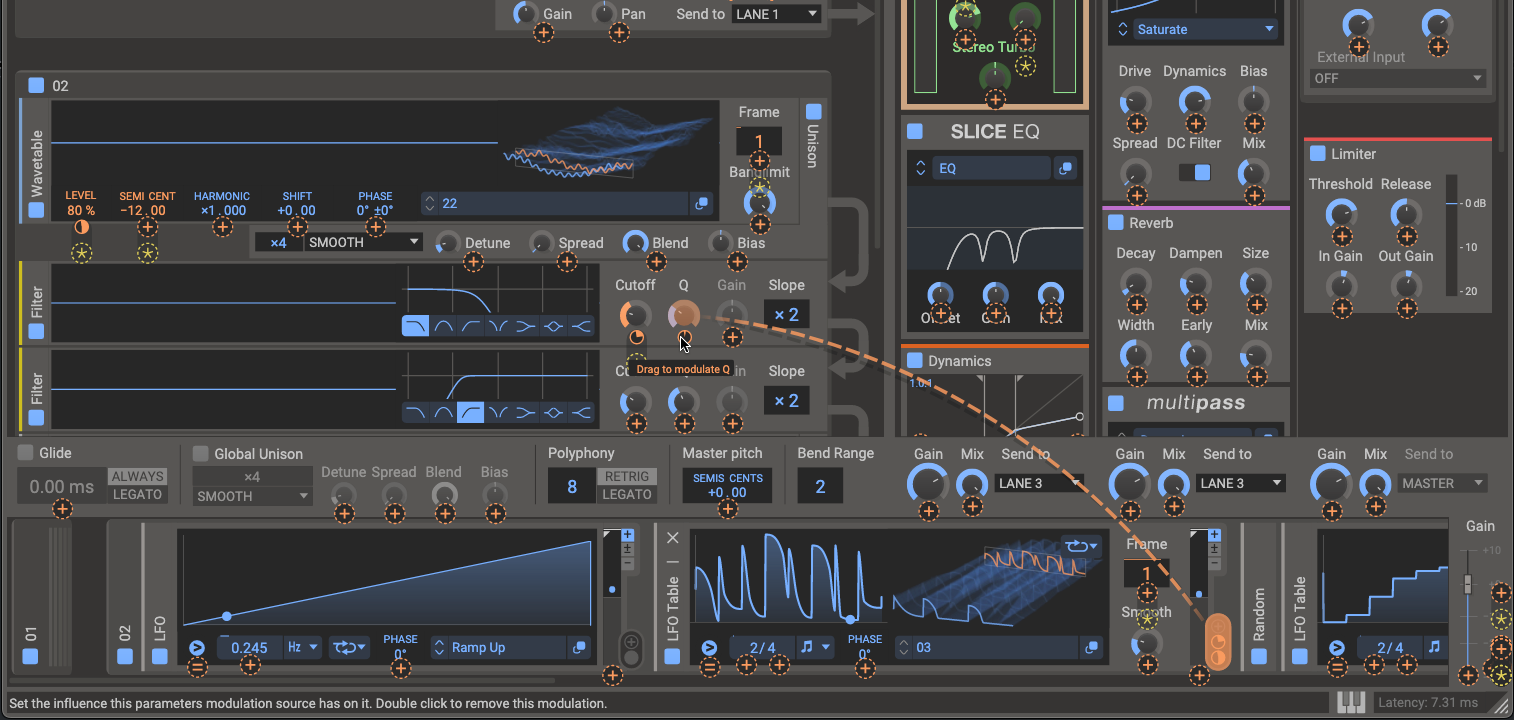
Summing up
For all its flexibility Phase Plant's innate 'building block' simplicity is sure to delight and teach you a thing or two in the process. Despite its open-ended and immensely versatile architecture, Phase Plant is remarkably easy to use, once you have grasped its concept. And all of this power is delivered without placing a massive strain on the host system.
Visualisations are detailed, informative and attractive, signal routing is logical and easy, and managing modulators remains intuitive and simple.
Verdict
Flexibility: 5
Ease-of-Use: 4
Sound: 4
Value: 4
Sound examples
Price: $199
Contact: kilohearts.com
Native Instruments Massive X
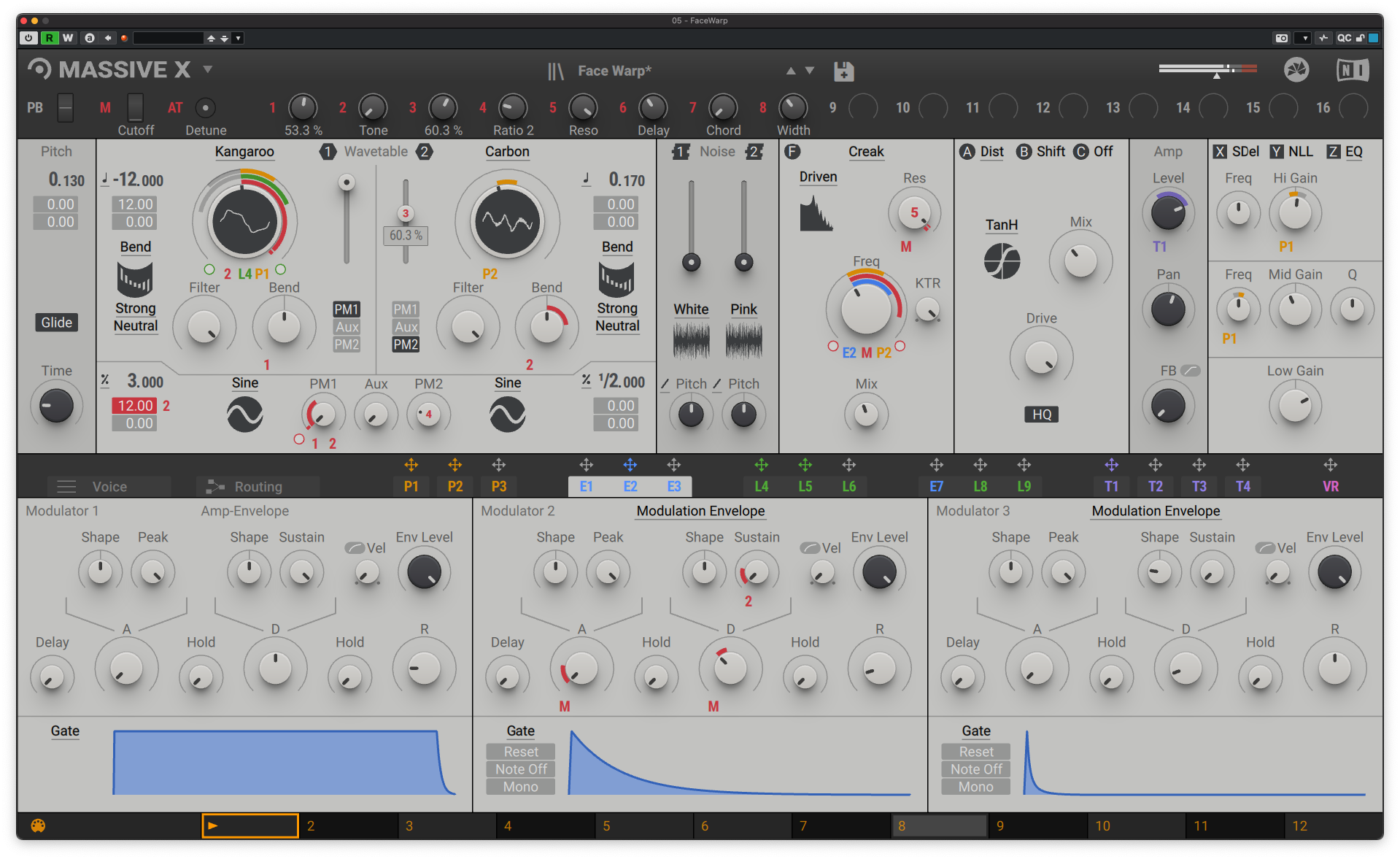
Massive quickly became a go-to in the early days of D'n'B and Dubstep, packing powerful, bone crushing leads and basses and forging a new route for sound designers. Massive X, as you would expect, takes that sound, complexity and capability to the next level.
At first glance its fixed pair of wavetable oscillators seem a trifle primitive compared to the other synths in this roundup, but while most wavetable synths can only traverse a wavetable's frames and, perhaps, apply wavetable folding (akin to adjusting the pulse width of a square wave), Massive X's oscillators offer a choice of 10 different methods for interpreting and working with the loaded wavetable, each resulting in significantly different sonic outcomes.
The combination of which – in the face of simpler fare elsewhere – makes Massive (in both original and X form) a bit of a law unto itself, especially as it uses a proprietary wavetable format, and so, while there's certainly plenty of options on board, there's no scope for working with your own custom tables.
Massive X also features a dual noise generator replete with a wide selection of noise samples, a single filter stage offering a choice of nine different models, three slots for hosting a choice of 12 sound processor models, and three slots for hosting any of nine effect models.
All of which combine to give it its distinctive 'slab of sound'.

But what really unleashes Massive X's sound design power is its open-ended routing system. In essence, and with few limitations, each of the synth's components can be patched to any other, in any order you like, via a simple graphical interface.
Massive X provides 17 modulation sources in total. One of these is hard-wired as the amp envelope, while a further eight slots can load any of the synth's two envelope and two LFO models.
The remaining modulation sources have dedicated uses: three are pattern sequencers for creating repeating loops of modulation values, four are advanced keyboard tracking curves, and one is a pseudo-random generator.

Summing up
All told, Massive X is a bit of a beast. Mapping is easy enough, using a click-and-drag method similar to all of the synths we're looking at, however, in Massive X's case, there are tighter limits on the number of modulators that can be applied to each parameter and, once mapped, there isn't much visual feedback about what each modulator is actually doing.
Meanwhile, sonically, Massive X lives up to its name, and is one of the less processor-hogging of the bunch. It is impressively flexible too, but accessing its full potential feels less intuitive and more 'tweak it and try' than with the other synths in our roundup.
Verdict
Flexibility: 4
Ease-of-Use: 2
Sound: 4
Value: 4
Sound examples
Price: £179 (available with 50% discount at time of writing)
Contact: native-instruments.com
Native Instruments Massive X review
Vital Audio Vital

Freeware and open-source music-making software has something of a chequered history, with many promising projects descending into abandonware before reaching maturity.
Thankfully, that's not the case with Vital.
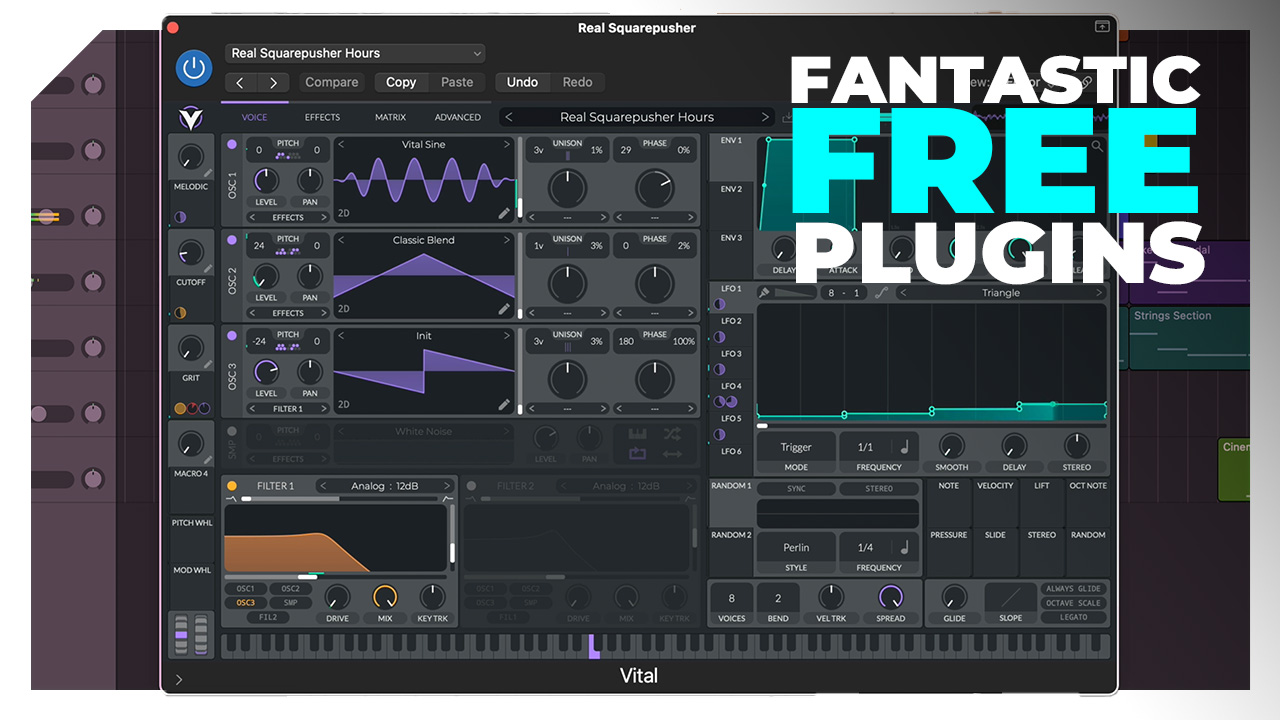
The synth itself is free – just create an account and download the software – while the Plus and Pro editions pack in additional presets and wavetables (amongst other things).
And in the latest update the synth is now available for both Intel and Apple Silicon on Mac.
Like Massive X, Vital is built around wavetable oscillators, of which it has three. The Basic edition comes with only 25 wavetables, but (unlike Massive X) it's easy to import custom wavetables, and the synth even features a capable wavetable editor if you want to try your hand at creating your own.
There's also a very basic sample oscillator intended for loading noise or basic waveform samples.
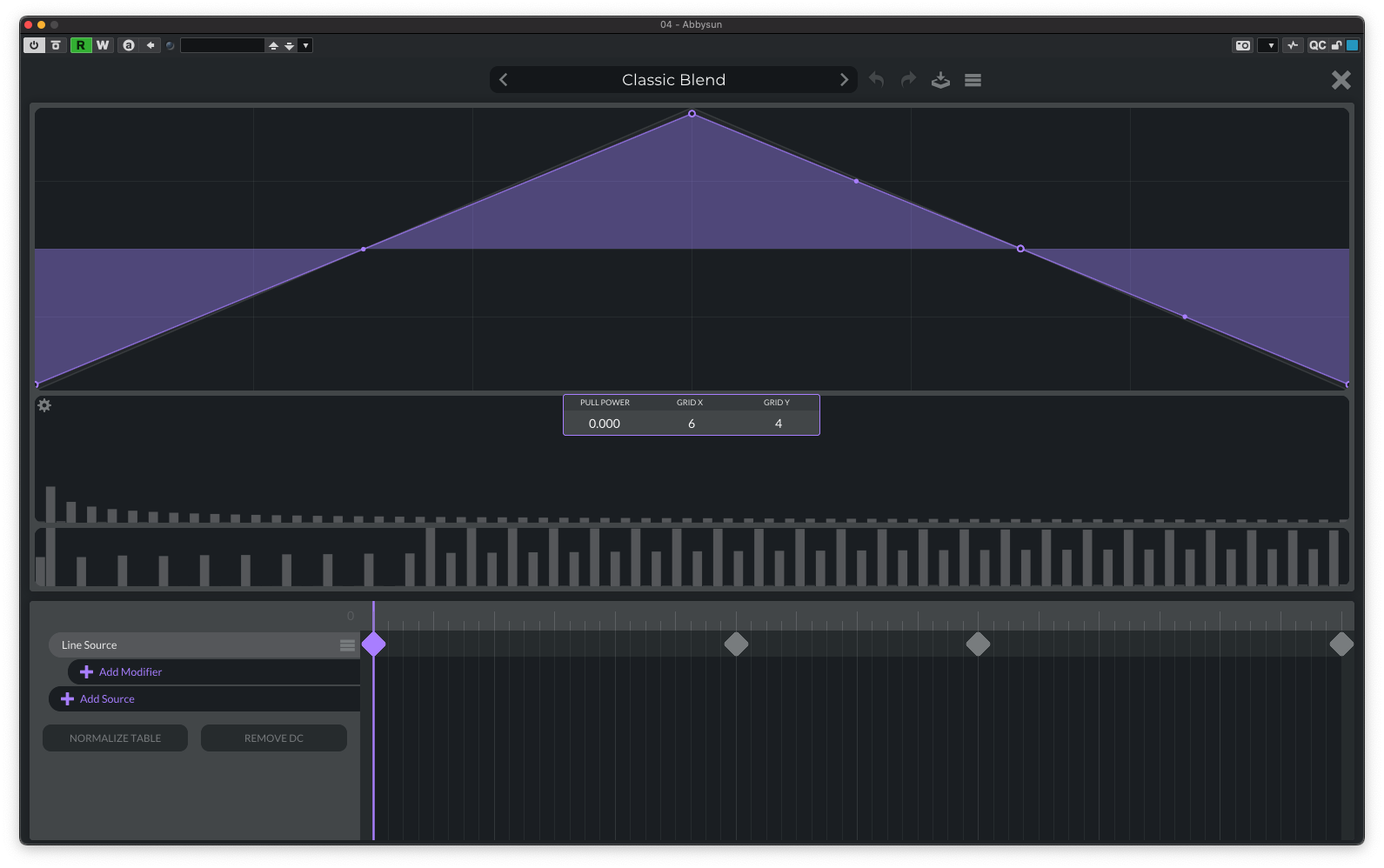
Each oscillator features note-snapping, useful for creating one-note chords that remain in-key, or if you're not the most accurate keyboard player. They also sport an efficient unison engine, a processing slot into which a choice of different filters and shapers can be loaded, and a flexible cross-modulation system for creating sync, FM and ring modulation effects.
Simple routing allows each oscillator to send its signal to either of the two filters, both filters simultaneously, or to bypass the filter stage altogether and route straight to the effects processing stage or directly to the output.
The two filters offer a good choice of different models – classic analogue, ladder, digital, and such – and a useful selection of shapes and slopes for each model. The filter output is sent to a stereo effect bus with a choice of nine processors, including reverb, compressor, delay, EQ, an additional filter, and more. The choice of processors is fixed, but they can be freely re-ordered.
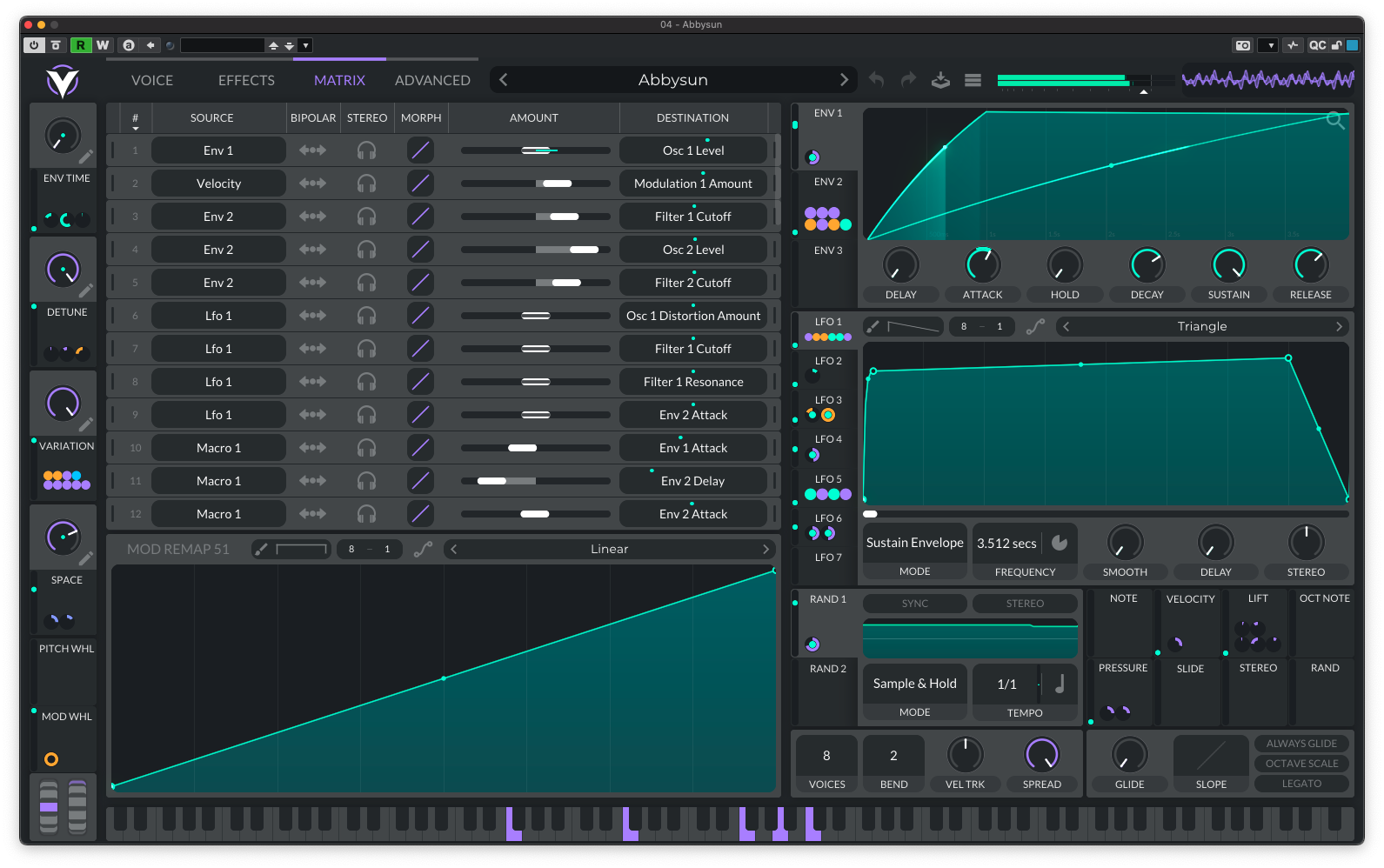
Vital has a large selection of modulators to work with: six DAHDSR envelopes (delay, attack, hold, decay, sustain, release), eight LFOs with fully customisable shapes, four random generators, four macro controllers, and a bunch of realtime and MPE control sources – mod wheel, keyboard tracking, slide, and so on.
As with all the synths we're looking at, mapping modulators to parameters is a simple drag-and-drop, but there's also a dedicated Matrix view from where modulation mappings can be created and managed.
Summing up
Sound-wise, Vital gives little away to its premium-priced competitors, delivering a rich and full-blooded a sound that's on par with the other synths we're looking at. It's also similar from a system usage point of view, able to be very lean with simpler patches but getting rather greedy when things become more complex.
It's remarkable that this powerful synth can be had for free, and upped to its full power for so little outlay. There really is no excuse for Vital not to be a regular go-to in your production workflow.
Verdict
Flexibility: 3
Ease-of-Use: 3
Sound: 3
Value: 5
Sound examples
Price: $0 (Basic Edition) / $25 (Plus Edition) / $80 (Pro Edition)
Contact: vital.audio
Xfer Records Serum 2

Xfer's long-awaited update to the wildly popular Serum appeared out of the blue back in March. For fans of the original, this new version has definitely been worth the wait, with the synth moving into the territory of Pigments and Phase Plant thanks to a new selection of models that can be loaded into the synth's three sound generator slots.
The wavetable engine of the original Serum is here, of course, with built in unison and two "Warp" slots into which various signal processors can be loaded. This is much the same as Vital, and is why many view Vital as a freeware equivalent of the original Serum.
But Serum 2 has beefed things up with a choice of Sample, Multisample, Granular and Spectral engines.
The Sample engine is conventional, and similar to Pigments' and Phase Plant's, but the Multisample engine offers far more flexibility than the maximum of six layers/articulations supported by Pigments' Sample engine.
Multisamples are defined in SFZ files, these being text files with a simple syntax that define all aspects of a multisample collection. Although text editing isn't as intuitive as the visual editor you may find in an actual sampler, Serum 2's use of SFZ files makes it possible to define very complex multisamples for use in the synth.

Serum 2's implementation of granular synthesis is fairly conventional and familiar, but the Spectral engine is somewhat more unique. It is conceptually similar to granular synthesis in that it separates the time and frequency dimensions of a sample so each can be manipulated independently, and whilst this gives sonic results that aren't dissimilar to granular synthesis, it is distinct enough to be a worthwhile alternative. In short, both engines turn any sample into a treasure trove of timbres from which to create new patches.
The filter section has two slots that can be arranged in series or parallel, and alongside the extensive collection of conventional and specialized filter models carried over from the original Serum are eleven new models. But, in a further encroachment on Pigments' territory, the majority these are based on classic synth filters such as the Moog Minimoog, Oberheim SEM, EMS Synthi, and EDP Wasp.
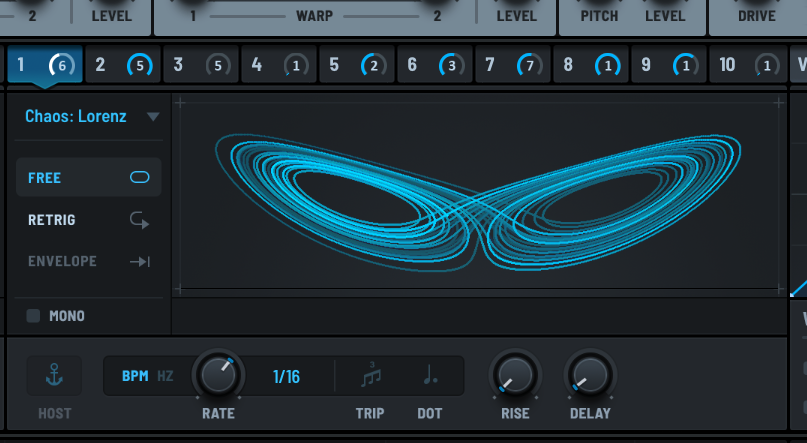
For modulation, Serum 2 provides four AHDSR envelopes, eight macro knobs, velocity and keyboard tracking, and six LFOs. These LFOs are quite special, with a choice of freely-drawable waveform, sample-and-hold, an option that tracks two dimensional paths that you draw, and a pair of chaos-based LFOs that produce fascinating non-repeating modulation patterns. Mapping of modulators is done via the same intuitive drag-and-drop system that's common across all of the synth's we're looking at.
Serum 2 features a powerful arpeggiator and a Clip player that stores and plays back predefined patterns and sequences. Each of these has 12 slots for storing patterns, with the active arpeggio or Clip pattern selectable either from the GUI or from a controller keyboard.
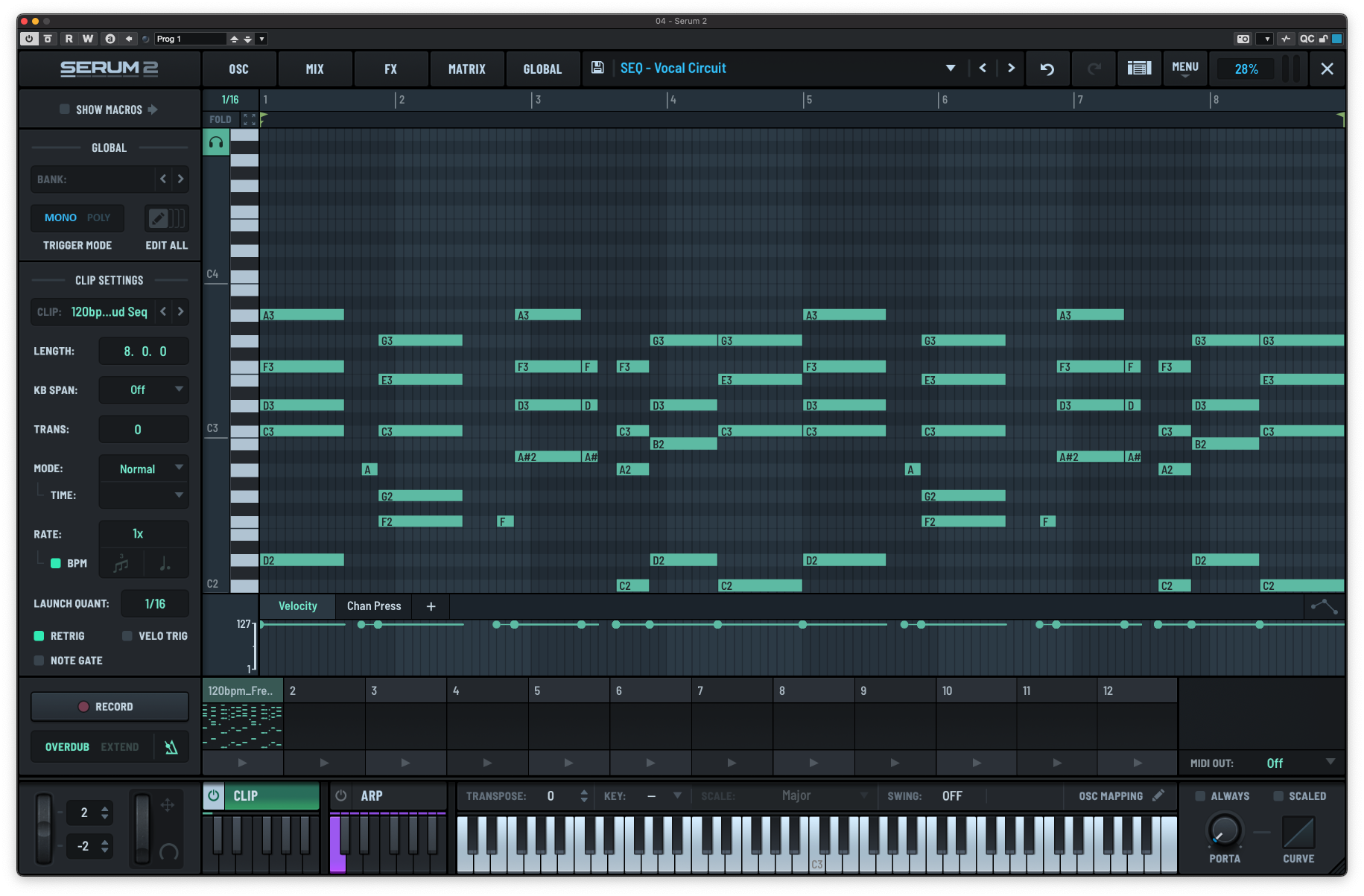
Summing up
Serum 2 is a powerful jamming and performance tool as well as a powerful synth. And, as with Pigments, the arpeggiator and Clip players can send their notes as a MIDI output with which to drive other synths.
Some early reports have observed that it's overbearingly demanding on the host system, but we didn't see anything better or worse than with any other synth in the roundup. It's all down to the complexity of the patch, with some being very demanding, and others barely registering on the CPU meter.
All in all, Serum 2 delivers the same rich, rounded and detailed sound as its predecessor, and easily holds its own alongside the other synth's we've gathered here. Our only gripes are that the included patch library seems less generous than some, and the asking price is the highest of the bunch.
Verdict
Flexibility: 4
Ease-of-Use: 3
Sound: 5
Value: 2
Sound examples
Price: $249 ($189 intro price until June 1st)
Contact: xferrecords.com
The Final Verdict
Though each has its strong points, all five of these instruments are immensely impressive. And while each has its own particular range of options and way of doing things, it's remarkable how close they all are in terms of sound quality and sonic versatility – marking and ranking them has not been an easy task!
Below, we've listed the winners in each category.
Coming in on top for flexibility and ease-of-use is Phase Plant, while Pigments 6 and Serum 2 are tied for first place in terms of sound. When it comes to value for money, Vital unsurprisingly snags our top spot.
That said, whether you want the warmth of analogue, the flexibility of digital, the realism of samples, or the fascination of the unconventional, these instruments can do it all.
If you have any of these plugins in your arsenal, you won't struggle to find the right sounds for your productions.
Best For Flexibility: Phase Plant
Best For Ease-of-use: Phase Plant
Best For Sound: Pigments 6 & Serum 2
Best For Value: Vital
You must confirm your public display name before commenting
Please logout and then login again, you will then be prompted to enter your display name.